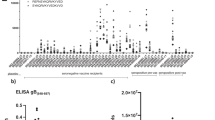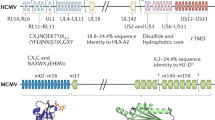Abstract
MUCH current interest is focused on the involvement of expressed products of the major histocompatability (H–2) gene complex, especially those associated with the K and D regions of H–2, in inducing cell-mediated immune responses and in permitting recognition and killing by cytoxic thymus-derived lymphocytes (CTL). Observations in many laboratories have led to the generalisation that syngeny between stimulator and target cells at the K and/or D region of H–2 is required for CTL activity to virus-infected cells1–3, minor histocompatibility antigens4, the male H–Y antigen5 and chemically modified syngeneic cells6–9. This study asks three questions related to the geneic restriction of induction and expression of CTL: (1) can non-infectious virus efficiently induce CTL, (2) can non-infectious virus absorbed to target cells render them susceptible to killing by CTL, and (3) can non-infectious virus absorbed onto or chemically linked to cells induce CTL and does using allogeneic or xenogeneic carrier cells affect this induction?
This is a preview of subscription content, access via your institution
Access options
Subscribe to this journal
Receive 51 print issues and online access
$199.00 per year
only $3.90 per issue
Buy this article
- Purchase on Springer Link
- Instant access to full article PDF
Prices may be subject to local taxes which are calculated during checkout
Similar content being viewed by others
References
Zinkernagel, R. M. & Doherty, P. C. Nature 248, 701–702 (1974).
Doherty, P. C., Blanden, R. V. & Zinkernagel, R. M. Transplant. Rev. 29, 89–124 (1976).
Blanden, R. V. et al. Nature 254, 269–270 (1975).
Bevan, M. J. exp. Med. 142, 1349–1364 (1975).
Gordon, R. D., Simpson, E. & Samelson, L. E. J. exp. Med. 142, 1108–1120 (1975).
Shearer, G. M. Eur. J. Immun. 4, 527–533 (1974).
Shearer, G. M., Rehn, T. G. & Schmitt-Verhulst, A.-M. Transplant. Rev. 29, 222–248 (1976).
Rehn, T. G., Shearer, G. M., Koren, H. S. & Inman, J. K. J. exp. Med. 143, 127–142 (1976).
Pfizenmaier, K., Starzinski-Powitz, A., Rodt, H., Röllinghoff, M. & Wagner, H. J. exp. Med. 143, 999–1004 (1976).
Schrader, J. W. & Edelman, G. M. J. exp. Med. 143, 601–614 (1976).
Doherty, P. C., Götze, D., Trinchieri, G. & Zinkernagel, R. M. Immunogenetics 3, 517–524 (1976).
Lewandowski, L. J., Gerhard, W. U. & Palmer, J. C. Infect. Immun. 13, 712–721 (1976).
Herberman, R. B., Nunn, M. E., Holden, H. T. & Lavrin, H. Int. J. Cancer 16, 230–239 (1975).
Kiessling, R., Petranyi, G., Klein, G. & Wigzell, H. Int. J. Cancer 17, 275–281 (1976).
Watkins, J. F. Methods Virol. 5, 1–32 (1971).
Likhite, V. & Schow, A. in Methods in Immunology and Immunochemistry 1 (eds Williams, C. A. & Chase, M. W.) 164–167 (Academic, New York, 1967).
Neff, J. M. & Enders, J. F. Proc. Soc. exp. Biol. Med. 127, 260–267 (1968).
Author information
Authors and Affiliations
Rights and permissions
About this article
Cite this article
PALMER, J., LEWANDOWSKI, L. & WATERS, D. Non-infectious virus induces cytotoxic T lymphocytes and binds to target cells to permit their lysis. Nature 269, 595–597 (1977). https://doi.org/10.1038/269595a0
Received:
Accepted:
Published:
Issue Date:
DOI: https://doi.org/10.1038/269595a0
Comments
By submitting a comment you agree to abide by our Terms and Community Guidelines. If you find something abusive or that does not comply with our terms or guidelines please flag it as inappropriate.



